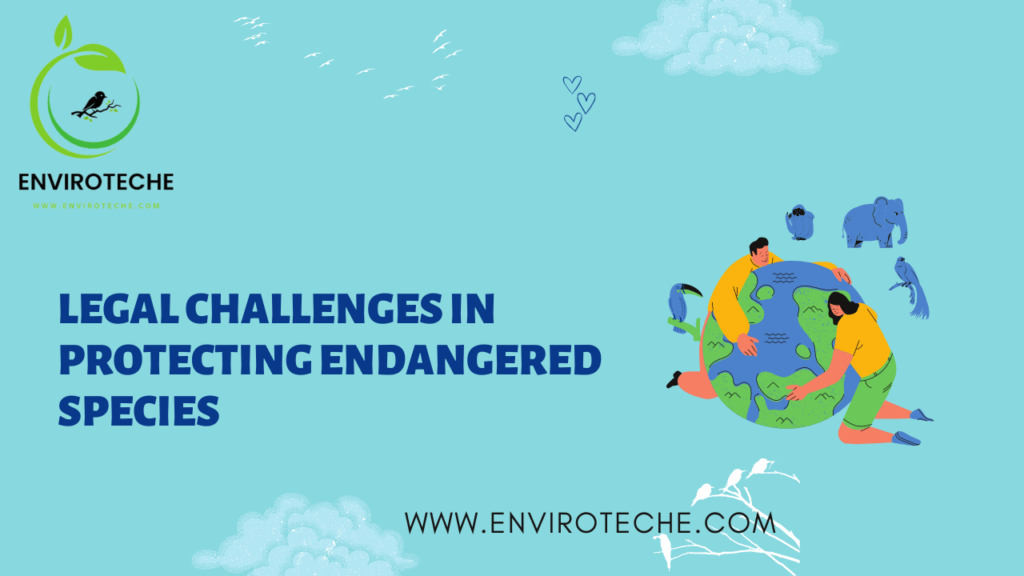
Legal Challenges in Protecting Endangered Species
Muhammad Qasim1, Nimra Ather2
Department of Environmental Sciences, Government College University Faisalabad1
Department of Zoology, University of Agriculture Faisalabad2
Introduction:
One of the most important issues facing the globe today is the preservation of endangered species. Numerous plant and animal species are in danger of going extinct because of a variety of circumstances, including habitat loss, poaching, and climate change. Although there are legal structures in place to protect these species, their execution frequently faces serious difficulties.
In this blog series, we will look at a few case studies that demonstrate the difficulties in conserving endangered species under the law and speculate on ways to get around them.
Case Study 1:
Ban on the Trade in Ivory and the African Elephant: Illegal poaching for ivory tusks has long been a concern to the African elephant. The Convention on International Trade in Endangered Species of Wild Fauna and Flora (CITES) was established to address this problem by enforcing a global ban on the trade in ivory. However, a number of legal issues, such as lax enforcement, corruption, and the development of black markets, have hindered the effectiveness of the ban. In order to effectively combat the illegal wildlife trade, more legal restrictions and international cooperation are required, which are both highlighted by this case study. It also throws light on the challenges of enforcing international legislation.
Solution:
Strengthening Enforcement and Punishments: In order to address the legal issues surrounding the ivory trade, nations must step up their efforts to police the law and impose harsher punishments for wildlife crimes. This might entail more financing for specialized law enforcement units, better training for officers, and stiffer penalties for violators. The exchange of intelligence, the coordination of activities, and the extradition of criminals involved in transnational wildlife trafficking all depend on international cooperation.
Case Study 2:
The critically endangered orangutan species is imperiled by the rapid habitat loss brought on by deforestation, and this poses a serious threat to their continued existence. Legal frameworks for land-use planning and forest protection frequently conflict with economic interests like agriculture and logging in nations like Indonesia and Malaysia. This case study demonstrates the intricate connection between environmental preservation and economic growth, which results in legal difficulties while preserving the habitats of endangered animals.
Solution:
Integrated Land-Use Planning and Conservation: It’s critical to create integrated land-use planning strategies that strike a balance between the need for conservation and sustainable economic development in order to address legal issues relating to habitat degradation. This entails creating protected areas, putting zoning laws into effect, and promoting sustainable farming and forestry methods. To guarantee that local communities’ rights and interests are upheld, governments should place a high priority on long-term environmental sustainability and involve them in the decision-making process.
Case Study 3:
Online Platforms and the Illegal Wildlife Trade: The expansion of the internet and e-commerce platforms has opened up new channels for the illegal wildlife trade. Online marketplaces can be used by traffickers to covertly sell endangered species and their parts. Despite efforts to control internet trade, jurisdictional problems, the secrecy of online transactions, and the sheer number of online marketplaces mean that legal obstacles still exist. This case study emphasizes the necessity for creative legal strategies to effectively address wildlife trafficking online.
Solution:
Governments and conservation organizations must work with online platforms to implement stronger policies and monitoring procedures in order to solve the issues posed by the illegal online trade in wildlife. This includes using cutting-edge tools like machine learning and artificial intelligence to find and remove lists of endangered species. Effective regulation and enforcement depend on collaboration between governments, law enforcement organizations, and online platforms.
Case Study 4:
The African elephant is one of the most well-known and imperiled species on the planet. They have severe legal obstacles despite international efforts to protect them. The illegal ivory trade, which encourages poaching and leads to the loss of elephant numbers, is one important problem. Although the international trade in ivory has been outlawed by the Convention on International Trade in Endangered Species of Wild Fauna and Flora (CITES), there are still black markets for the commodity. Significant barriers to addressing this issue include a lack of effective law enforcement, corruption, and insufficient punishment for violators.
Solutions:
Several steps might be made to overcome the legal difficulties in safeguarding African elephants. Raising the presence of anti-poaching units and creating specialized wildlife crime investigative units are just two ways to strengthen law enforcement efforts. The networks of illegal commerce can also be broken up by toughening punishments for ivory traffickers and stepping up international collaboration in intelligence sharing and law enforcement. It is also crucial to educate the public about the negative effects of poaching and the value of protecting elephants.
Case Study 5:
The Sumatran Tiger: Only found on the Indonesian island of Sumatra, Indonesia the Sumatran tiger is a severely endangered species. Significant concerns to their survival include habitat degradation, poaching, and the illegal trafficking of wildlife. The encroachment of human activities like logging, mining, and agriculture on this species’ habitat is one of the legal obstacles to safeguarding it. Illegal land clearing persists despite national legislation and protected areas, resulting in habitat fragmentation and an increase in human-tiger confrontations.
Solutions:
The Sumatran tiger needs to be protected in various ways. To stop unauthorised encroachment into tiger habitats, land-use planning must be strengthened, and regulations must be strictly enforced. Collaboration with local communities and offering them different means of subsistence can lessen their reliance on activities that endanger tiger numbers. The prospects of the tiger surviving can be improved by expanding protected areas and enhancing their management, including stepping up anti-poaching patrols. Additional actions that can be made include promoting tiger conservation and participating in international cooperation to combat the illegal wildlife trafficking.
Case Study 6:
The Hawaiian Monk Seal: A marine animal native to the Hawaiian Islands that is in risk of extinction is the Hawaiian monk seal. They are in danger from a number of factors, such as habitat loss, entanglement in debris from the ocean, and human interference. Despite legislative safeguards, the lack of enforcement and oversight of laws puts this species’ survival in jeopardy. The persistent difficulties are a result of inadequate funding for conservation initiatives, scarce resources for research and rehabilitation, and a lack of public awareness. Endangered Species
Solutions:
Increased funds and resources are required to support conservation activities, research, and monitoring efforts for the Hawaiian monk seal. Threats to the species can be lessened by strengthening the laws and rules governing marine trash and human disturbance. Through education and awareness initiatives, local communities, stakeholders, and fishermen can be involved in seal conservation efforts. This can encourage a sense of ownership and establish a conducive atmosphere for their protection. Endangered Species
Conclusion:
Protecting endangered species requires overcoming a number of legal challenges, including lax enforcement, corruption, and conflicts between preservation and commercial interests. Case studies on the orangutan, the African elephant, and unlawful internet commerce make it abundantly evident that the best solutions involve improved enforcement, integrated land-use planning, and collaboration with online platforms. To address these legal concerns and ensure the survival of endangered species, governments, international organizations, and civil society must work successfully together. Endangered Species
Check Other Schlorships:

